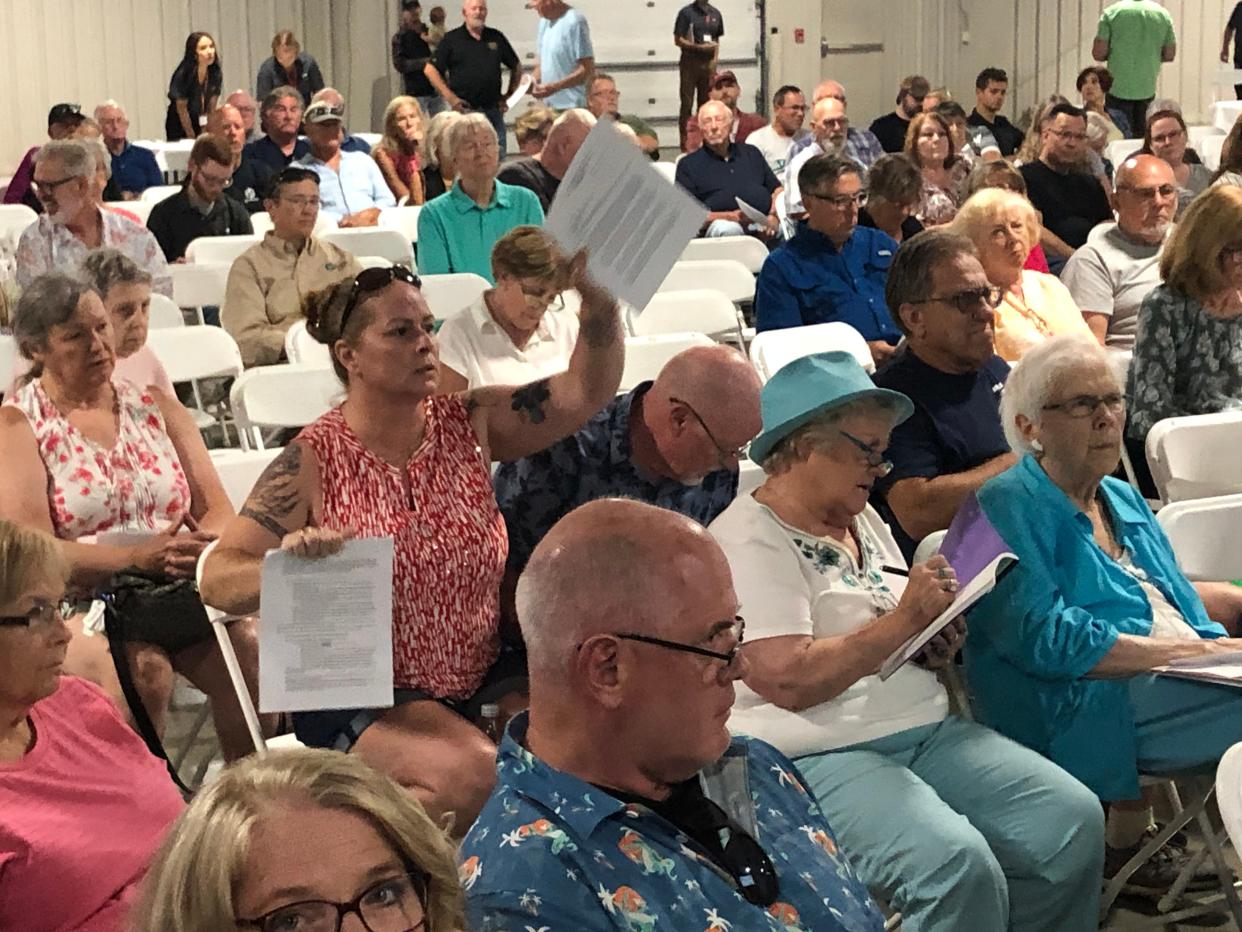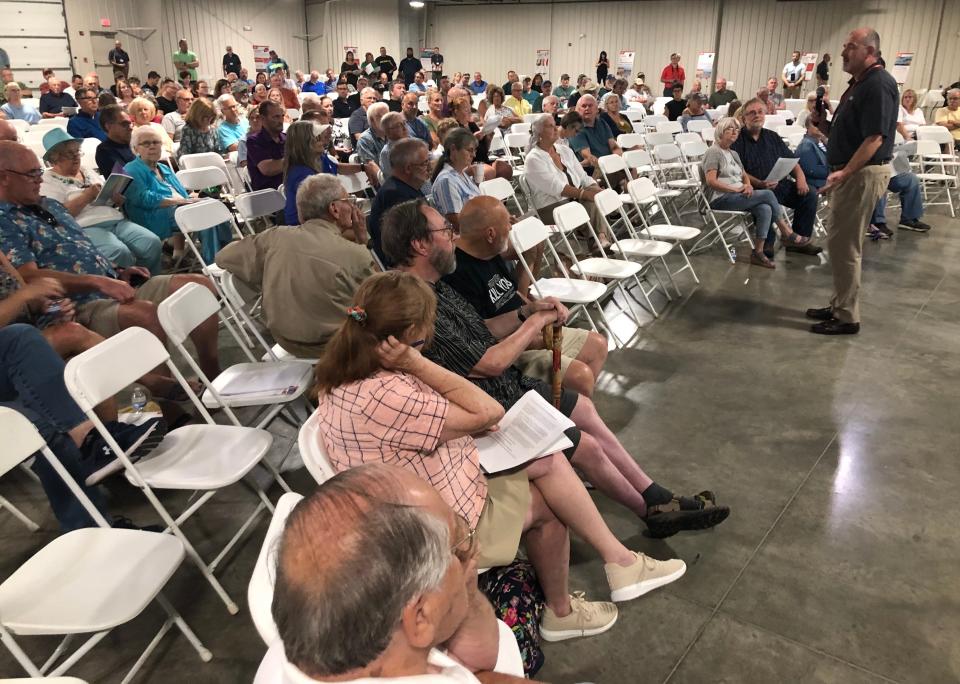What would happen if St. Joseph River dams removed? Homeowners press I&M for answers.

ELKHART — A century ago, hydroelectric dams went into the St. Joseph River in Elkhart and Mottville, Mich., and changed the landscape, which led several people to build homes along the scenic, widened riverbanks where it’s almost like a lake.
So, the initial announcement that Indiana Michigan Power has started to think about the fate of the aging dams — whether to keep them or tear them down — drew hundreds of people who live along the waters to the Northern Indiana Event Center on Tuesday and Thursday to beg questions.
What will the river look like if the dams are decommissioned? If the river level drops in many parts, as several expect, who would own the new swaths of dry land between the river’s edge and their piers, docks and seawalls?
Brian Bergsma, I&M’s director of governmental affairs, replied to a parade of worried residents’ questions at the open houses, often repeating that the company will know more after it conducts a study.
“We don’t have the answers to a lot of questions,” he said, adding that it’s early in the process. “We are trying to be as proactive as possible. … No decisions have been made. I cannot emphasize that enough.”
Many seemed to remain skeptical, believing the company knows more than it’s sharing.
One resident pushed for computer models of what it would look like if the dams are removed.
“We could show videos online (of potential impacts),” Bergsma responded. “But those aren’t ours. It would be disingenuous. We don’t know if they are accurate.”
Elkhart city council member Brent Curry, who doesn’t live on the river, said he’s heard from many residents so far who live on the river or know someone who does: “Everybody said don’t decommission the dams.”
“It’s important that they share complete information with us,” James Skillen, who lives on the river in Mottville, told The Tribune. “We are lay people, and we want transparency.”
His fiancé distributed sheets to other residents at Thursday’s meeting that list a series of technical questions. The sheets express disappointment in the lack of answers that were given on Tuesday.
Skillen said he’s urging for monitoring information for both dams, but he’d also like to see new, much more efficient dams. He’s concerned for the dams’ current state. Each year, he said, he receives a federally required letter that informs him that, if the Mottville dam fails, his home could be flooded or worse.
What I&M is weighing in its decision
The Elkhart dam began operations in 1913 and the Mottville dam in 1923. If their aging issues aren’t addressed, I&M has stated at a website about the process, it could lead to “escalating maintenance costs” and affect the river’s flow and wildlife.
They are among six dams that I&M operates.
“I&M is carefully examining several options, as the facilities’ Federal Energy Regulatory Commission (FERC) license comes due,” the utility further states. “This input will help guide considerations for the potential relicensing or decommissioning of the facilities. I&M is committed to gathering community feedback and analyzing impacts on recreation, the environment, the local economy, and other factors.”
Both of the Elkhart and Mottville dams are in “stable” condition and are regularly maintained, Bergsma said. He added that the company attempted a dam repair this past winter, then, unsatisfied with the result, did a second but successful repair this spring. He said there was seepage at the bottom of the dam that was fixed.
But the last time the dams were reevaluated for relicensing was about 30 years ago, he said, and it’s a different process now.
At the same time, I&M is also weighing how much hydroelectric power should factor into its mix of energy sources, alongside solar, wind, coal and natural gas. It would go into what’s known as an integrated resource plan for the next 20 years, which is filed every three to five years. That planning process will run through 2026.
One resident asked why not prioritize hydroelectric power since it’s clean with no carbon footprint.
Bergsma said the company’s six dams generate enough electricity to power about 15,000 to 20,000 homes. Specifically, the Elkhart dam generates 3.44 megawatts, and the Mottville dam generates 1.68 megawatts.
I&M’s study — potentially answering several of the questions — will eventually become public in its integrated resource plan, Bergsma said.

The open house, though, was an effort to start listening to residents’ concerns, which he said are helpful as I&M weighs the many factors that go into its decision.
“There’s nothing in this process that obligates us to have this meeting,” he said.
There are many questions that didn’t surface Thursday about how removing the dams might affect fishing, kayaking and other kinds of recreation, which I&M has said are also factors.
Some members of the local Paddle Michiana group, in their Facebook group, generally tout the prospect of replacing dams with a series of rock-strewn rapids to provide whitewater kayaking.
Outdoor Adventures in 2021: Paddlers can launch on Dowagiac River at old Niles dam. But not beginners.
Jonathan Hamm walked away Thursday wondering what he’d do if the river level dropped by his home between I&M’s Twin Branch dam in Mishawaka and the Elkhart dam.
“Are they going to pay me for the seawall I put in because of the dam?” he said.
Near his home, he’s seen mink, otters, beavers, osprey, turkeys and eagles, along with migrating pelicans and loons. They visit and dwell around a landscape that changed a century ago.
“There’s a whole ecosystem that’s built up around this,” he said.
How to provide feedback
You can learn more about I&M’s process for the dams and give your feedback, including through a brief online survey, at www.hydrocommunityconversation.com. Residents can also call 614-259-8201.
South Bend Tribune reporter Joseph Dits can be reached at 574-235-6158 or jdits@sbtinfo.com.
This article originally appeared on South Bend Tribune: I&M hears questions about St. Joseph River dams in Elkhart Mottville

